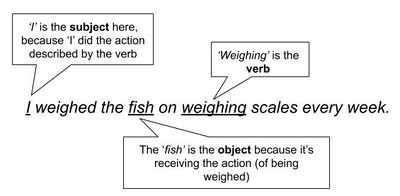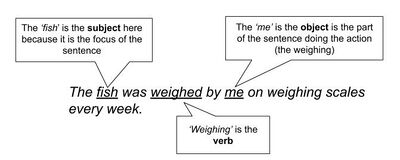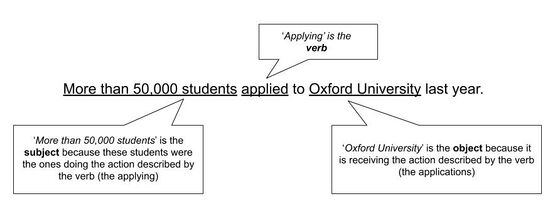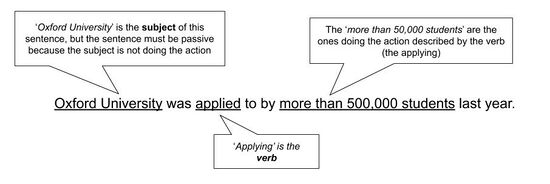Many people are confused by whether they are using the active or passive voice when writing, and in which scenario each is preferred. Thankfully, there is a simple way of identifying the two styles; the key to understanding the difference between them is to spot the subject and the object in each sentence, and then selectively order the way you introduce them.
In an active voice sentence, the subject is the element that is doing the action, whereas the object is the element that is receiving the action described by the verb. In contrast, in a passive sentence, the element targeted by the action is promoted to the subject position. This can sound confusing, but a good way to learn this concept is to realize that a passive sentence will result in the subject effectively doing nothing, because whatever is happening is being done to it.
Some examples
Example #1:
1A) Consider the following active voice sentence:
This cannot be a passive sentence because the subject is doing something to the object (weighing it).
1B) Now consider the passive voice version of the previous sentence:
This cannot be an active voice sentence because the subject is effectively doing nothing.
Example #2:
2A) Consider the following active voice sentence:
It cannot be a passive sentence because the subjects are doing something (applying) to the object.
2B) Now, consider the passive voice version of the previous sentence:
You might be developing the impression that using the active voice is always preferable, but this is not the case. Using the active voice is generally preferable because it tends to help you write more concise sentences and makes use of stronger verb forms. However, using the passive voice is acceptable in many situations, and is actually preferable when:
- You want to be purposefully vague. For example: ‘The study was compromised due to a methodological error,’ rather than ‘Mike made an error, which compromised the study.’
- You don’t know the identity of the ‘doer’. For example: ‘The cave paintings were made over 5,000 years ago,’ rather than ‘Someone made the cave paintings over 5,000 years ago.’
- The ‘doer’ is not important. For example: ‘An experimental traffic system will be trialled in British Columbia,’ rather than ‘RoadCorps will trial an experimental traffic system in British Columbia.’
At times, using a mix of active and passive voice may make sense (Anderson 2015).
Why does this matter?
In the examples listed above, the passive voice versions are not especially long-winded, yet if you re-examine them you will notice that they feature more words than their respective active versions. This is of great relevance to you as science writers because it is very important that you always try to communicate things as concisely as possible. When you start to write more complex sentences, the difference in word count can be significant when you compare the active and passive voice versions, and this is important in a setting in which waffly, vague statements are always your enemy.
Along with a lack of conciseness, ambiguity (being vague) is the other unwanted attribute that comes with the use of passive voice sentences (Inzunza, 2021). For example, consider the following active and passive versions of a sentence that might appear in the methods section of your lab report:
3A: Professor Roberts kept the mice in their cages for three weeks. He then released them into the wild and recaptured them three weeks later.
3P: The mice used in this experiment were kept in their cages for three weeks before they were released and then recaptured after they had spent three weeks in the wild.
Note firstly that the active voice version features 24 words in comparison to the 30 in the passive one, yet, importantly, the active version explains exactly what happened and who did what, whereas the passive one leaves these specific details out.
But, sometimes you should use the passive voice…
You might be developing the impression that using the active voice is always preferable, but this is not the case. Using the active voice is generally preferable because it tends to help you write more concise sentences and makes use of stronger verb forms. However, using the passive voice is acceptable in many situations, and is actually preferable when:
1) You want to be purposefully vague.
- For example: ‘The study was compromised due to a methodological error,’ rather than ‘Mike made an error, which compromised the study.’
2) You don’t know the identity of the ‘doer’.
- For example: ‘The cave paintings were made over 5,000 years ago,’ rather than ‘Someone made the cave paintings over 5,000 years ago.’
3) The ‘doer’ is not important.
- For example: ‘An experimental traffic system will be trialled in British Columbia,’ rather than ‘RoadCorps will trial an experimental traffic system in British Columbia.’
4) You are referring to a general truth.
For example: ‘Rules were made to be broken,’ rather than ‘The person who made these rules made them to be broken.’
References
Anderson, Maureen. “Passive, Active, or Both? Which voice to use when writing science reports.” Teaching Science: The Journal of the Australian Science Teachers Association 6, no. 1 (2015): 50-51. https://search.informit.org/doi/10.3316/informit.081858773153004
Inzunza, Ernesto Ruelas. “Reconsidering the Use of the Passive Voice in Scientific Writing.” The American Biology Teacher 82, no. 8 (February 2021): 563-565. https://doi.org/10.1525/abt.2020.82.8.563




